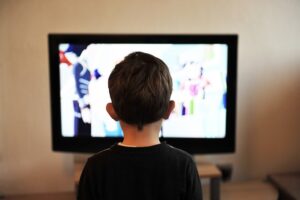You are not alone if your television turns on but displays no images. Regardless of the brand and model of their TV, anyone can experience this situation because it is a common problem.
As with most people, when this dawned on me for the first time, I initially thought my television was doomed. My presumption was that there was a flaw in the machinery that would require taking the television apart.
However, it was much easier than that. The steps I took to restore the visual display’s functionality are listed below.
You must start your television’s soft reset in order to solve this issue. First off, turn off the power to your TV. Press and hold the power button on your television for 15 seconds while keeping it unplugged. After pressing the power button for the required amount of time, release it and wait another 30 seconds before plugging your TV back into the outlet.
Perform a Soft Reset on Your TV

Explanation of Soft Resetting a TV
When faced with technical difficulties, performing a soft-reset on your TV should always be your first course of action. It’s common for people to overlook this step because they assume it won’t work.
A soft reset is the idea of turning off a device and then turning it back on without erasing any data that may have been previously stored. We’ll carry out a similar action, but with a slight modification.
Step-by-Step Guide to Soft Resetting Your TV
- In the beginning, unplug your TV from the wall outlet. It’s crucial to remember that a surge protector, which is notorious for causing power problems, shouldn’t be plugged into your TV.
- Find the power button on your TV while it is still unplugged. The power button should be pressed and held for about 15 seconds. Use the power button on the TV, not the remote, at all times. Pressing and holding the power button helps to drain the excess power that your TV’s capacitors are storing even when it is unplugged, allowing your TV to reset completely.
- Release the power button after the allotted 15 seconds have passed, then wait an additional 30 seconds before plugging your TV back into the wall.
Usually, taking these three easy steps will fix the problem. However, if the picture on your TV is still not working, keep reading for more advice.
Check All TV Connections
Importance of Double-Checking All Connections
Verify all TV connections if your TV is still not working after performing a soft reset.
It is essential to double-check every connection to your television because even one loose connection can result in a total loss of sound or picture. Unintentionally snagging a connector or causing a cable to come loose are both common occurrences.
Therefore, you can make sure that everything is securely connected and properly connected by checking all of the connections to your TV. This can save you the trouble and money of having to replace individual parts or buy a new TV.

Step-by-Step Guide to Checking Every TV Connection
The steps to double-checking every connection on your TV are as follows:
- Start by unplugging everything from your TV’s external connections, then wait 30 seconds before plugging everything back in. As loose connections can result in display problems, make sure that every connection is solid and tight.
- If your TV has multiple HDMI ports, try connecting your external device to one of them. Occasionally, HDMI ports can degrade with use, and changing to a different port might fix the problem.
- Make sure none of the cables or cords are damaged by inspecting each one. Use a different cord of the same type and see if that resolves the issue if you suspect a defective cord is to blame.
- If you’re trying to use an external device, make sure your TV is set to the appropriate input or source channel. Typically, HDMI is used to connect external devices to your TV, and there is a corresponding number for each HDMI port on the back of your TV. Make sure the channel you choose is appropriate for the gadget you want to use.
By taking these actions, you can eliminate any potential connection problems and focus on the issue at hand, making it simpler to troubleshoot further if required.
Use an Alternate External Device
When using an external device, such as a cable box or a game console, and getting sound but no picture on your TV, it’s possible that the problem is with the external device rather than your TV.
If you want to know if this is the situation, try unplugging the external device and see if the problem still exists when using the TV by itself. Alternately, attempt using a different external device and see if your TV and it are compatible. If your TV functions normally without the external device, it is most likely the device and not your TV that is malfunctioning.
Hardware Issues
It’s likely that your TV has a hardware issue if you’ve tried all the troubleshooting techniques previously mentioned and your screen is still blank.
Methods for Diagnosing Hardware Problems
You can take the following actions to identify the hardware problem with your TV:
- Switch on your TV while turning out the lights. Check the back of your television to see if the back vent is letting any light in. Not all TVs will have a vent to look through, so keep that in mind. If you do, your TV’s “backlight” is still on and functioning. You most likely have a defective T-Con board or main board (motherboard) in this situation.Normally, the only way to identify the problematic board is to replace each one individually. Your TV still has sound, so the T-Con board is probably to blame since that is the case.
- If there was no light coming from the back vent in the previous step, your TV’s backlight is not functioning. In this situation, switch off the lights once more and switch on your TV. Activate the TV’s menu, then use a torch to illuminate the display. On the screen, look for menu indicators. When you can make out the faint outline of the TV menu, move the torch around while keeping it just a few inches from the screen.
When you shine a torch on the TV screen, you should be able to make out the TV menu. If not, your inverter or LED driver may be damaged even though your T-Con board and main board are likely working properly.
You might need to replace the power-supply board in some TV models as the inverter or LED driver may be integrated into it.
The LED strips might be the problem if the inverter/LED driver is not at fault. One broken light is all it takes for the entire strip to go out. Unfortunately, to fix any of these hardware problems, you must disassemble your TV.

Contact Support
Contacting support is a good first step if you are having trouble getting the picture on your TV to work. The majority of TV manufacturers provide numerous support options, such as mail-in service and in-home repairs.
It’s important to weigh the cost of repair versus the cost of purchasing a new TV before giving up. In some circumstances, repairs can be very expensive, making it more cost-effective to buy a new TV. However, a technician might be able to identify the issue and give you repair options and price estimates so you can make a well-informed choice.
Your budget, the cost of repair, the age and condition of your current TV will all play a role in your final decision regarding whether to repair or replace it. Before making a choice, it is always a good idea to do your research and consider all of your options.
Verify Your Warranty
If you’re experiencing issues with your TV’s picture in addition to contacting support, you can also see if your TV is still under warranty. A manufacturer’s warranty is often included with TVs, and it usually covers repairs or replacements for a set amount of time.
Even though the majority of warranties only last for a year on average, it’s still worthwhile to see if your TV is still covered. If so, you might be able to get the issue fixed without paying anything. You can check the warranty information in the TV’s packaging or go online to the manufacturer’s website and enter the model and serial number of your TV to find out if it is still covered.
It’s important to read the terms and conditions of the warranty carefully because the warranty coverage may vary depending on them. Furthermore, some warranties might ask you to ship your TV to a service facility for repairs, which is inconvenient and might cost more money. However, before considering any other options, it is always worthwhile to see if your TV is still covered by warranty.
Wrapping it up
In conclusion, it can be frustrating to have a TV with no picture, but there are a number of solutions you can consider. By checking the connections and settings on your TV, you can first try to troubleshoot the issue on your own. If that doesn’t work, you can get in touch with your TV’s manufacturer’s customer service to look into repair options.
While most warranties are only good for a year, it’s still worthwhile to check to see if your TV is still covered. You must compare the price of repairs versus the price of buying a new TV if your TV’s warranty has expired.
In some circumstances, especially for older models, repairs might be more expensive than purchasing a new TV. However, a technician might be able to identify the issue and give you repair options and price estimates so you can make a well-informed choice.
Your budget, the cost of repair, the age and condition of your current TV will all play a role in your final decision regarding whether to repair or replace it. Before making a choice, it’s critical to do your homework and consider all of your options.
You May Also Enjoy Reading: No Picture on TV? (Audio, but No Video!)
